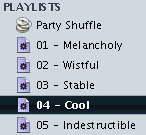How to Transfer Music from iPod to Computer
My post about transferring my iTunes library got a lot of traffic, and a lot of great comments in which people shared their experiences and expanded on my advice. The post still gets a lot of hits, and people have been asking me for the best techniques of moving music off your iPod onto your computer. Being neck-deep in writing a book, I haven’t a lot of time to experiment directly with the various methods yet, but I thought it would be helpful to round up some resources and talk about the leading techniques that are out there.
Apple doesn’t want you taking music off your iPod and putting it onto a computer, because they’re worried about unauthorized trading. But if your hard drive crashes and take your entire music collection, being blocked from shifting your iPod contents back onto your new laptop is going to be infuriating. Fortunately, there are ways.
The Do-It-Yourself Windows Solution
If you’re trying to get your music onto a Windows machine, it’s not so hard. Windows thinks of your iPod as a simple storage device, and if you know how to find the files, you can grab them as easily as you’d pull them off a thumb drive.
For step-by-step instructions, check out Method One in this easy-to-digest article. That 2007 article is a little outdated — it goes on to suggest several software programs that are no longer available — but its instructions for getting into your iPod’s hidden music folder (where everything will look like alphabet soup) are still good. Depending on your version of Windows, finding the hidden files might be slightly different process (in Windows 7: After clicking on the iPod under My Computer, click on Folder Options, and under the View tab, select “Show hidden files, folders, and drives.”)
But pay attention to that initial step about not having your iTunes set to automatically sync your iPod, or the first thing you do will be to wipe your iPod clean. The writer here had only tested the technique with music files, which works fine (although you lose the metadata). I haven’t tested it yet with videos and other media.
This video also outlines how to browse – and transfer from – your iPod as if it were just another hard drive:
If you’re looking to get the iPod content onto a Mac, you’ll need a software program that will do it for you.
Free Software Solutions
If you want a program that will transfer music from iPod to PC without you having to do the backdoor work yourself, Sharepod comes pretty highly recommended. Download.com gives it a glowing review, and the program promises to grab songs, pictures, videos and other content, as well as your playlists, album art and ratings, from your iPod (or iPhone) and pull them to your PC.
Floola is a freeware program that offers to do a lot of things besides copy music off your iPod, from copying YouTube videos to synchronizing with your Google Calendar. Comments I’ve seen are strongly positive but, like any free program, slightly mixed. Check out reviews at Download.com and Lifehacker for starters.
If music is your only problem, FreeSync for Mac will readily move the files. If you’ve got video, photos, etc., the maker will want you to pay for the more robust version (see below).
Another free solution is iPod Folder, which works for both PCs and Macs. The drawback: Not only does it not do video, it only handles MP3 files, so if you’ve purchased music from the iTunes store, or ripped your CDs into any format other than MP3, this one won’t help you.
Solutions You Can Pay For
There are a number of programs you can buy for, of course. They’ll usually start you out with a free demo that gives you a number of days and songs before you need the license. I’m limiting the scope of this quick survey to free solutions, but here are a couple of pay-to-play programs that kept popping onto my radar:
One leading contender is Senuti, which gives you 30 days or 1,000 songs free before asking $18 for a license. Here’s a full review that walks you through the process of transferring your music from iPod to Mac.
iSkySoft, whose FreeSync for Mac moves songs for free, offers to get everything off your iPod with either of two programs, SyncPod for Mac, which will run you $39, or SyncPod for Windows, whose lower price tag ($19) may be due to the greater number of free solutions for the PC user.
What Else Have You Got?
I won’t get around to actually experimenting with these programs and techniques until either the book hits the shelves or a hard drive failure wipes out my iTunes library, but until that great or disastrous day, this post should get you started. If you’ve used any of these programs or techniques, or have a different or better solution, comment away!

